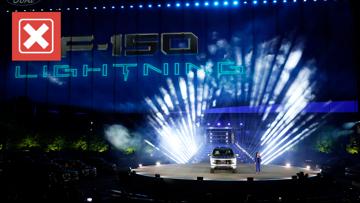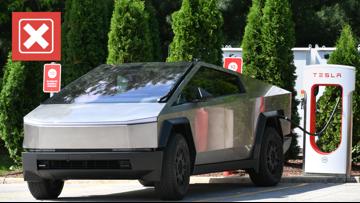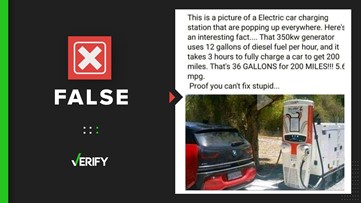The Inflation Reduction Act made significant changes to the kinds of tax credits people could get for buying electric vehicles in the U.S.
Under the law, which President Biden signed in August 2022, taxpayers who purchase certain new or used electric vehicles or plug-in hybrids may be eligible for a federal income tax credit of up to $7,500. The tax credit will be available to qualifying taxpayers until 2032.
On Jan. 1, 2024, the government rolled out new eligibility rules for the tax credit. Recent online search trends show many people want to know what’s changed and which EVs qualify for the tax credit.
Here’s what we can VERIFY about the changes to the EV tax credit in 2024.
THE SOURCES
- Inflation Reduction Act of 2022
- U.S. Department of the Treasury
- Internal Revenue Service (IRS)
- FuelEconomy.gov, the official U.S. government source of fuel economy information
- Consumer Reports
- H&R Block
- Kelley Blue Book
- Kiplinger
- Plug In America
- NerdWallet
WHAT WE FOUND
1. What is the electric vehicle tax credit?
The clean vehicles tax credit, which is known as the electric vehicle (EV) tax credit, is a tax credit offered to people who buy qualifying all-electric (EV), plug-in hybrid (PHEV) or fuel cell electric (FCV) vehicles in the U.S. Other types of alternative fuel vehicles don’t qualify.
Under rules established in the Inflation Reduction Act of 2022, the EV tax credit allows eligible taxpayers to claim a maximum credit of $7,500 for new EVs, and up to $4,000, limited to 30% of the sale price, for used EVs.
Starting on Jan. 1, 2024, eligible buyers can choose between getting an instant EV tax rebate to use as a down payment on qualified new or used vehicles at the time of purchase at a registered dealership under new rules established by the IRS, or they can claim the credit on their tax return. Before this change, people only had the option of claiming the credit on their tax returns the following year.
To get the instant tax rebate, Kelley Blue Book says the tax credits must be initiated and approved at the point of sale. The new rules also require the dealer to submit a “time of sale report” containing buyer and vehicle information to IRS Energy Credits Online. Buyers must get a copy of the submitted report from the dealer, along with confirmation that it was accepted by the IRS, to use when filing their tax return.
According to the Treasury Department, the near-instant tax credits will lower purchasing costs for more Americans and help car dealers by boosting EV sales.
2. Who qualifies for the electric vehicle tax credit in 2024?
To qualify for the EV tax credit, the IRS says you must purchase the vehicle for personal use and use it primarily in the U.S.
There are also income limits for new and used vehicles. For new vehicles, the IRS says qualified buyers cannot have a modified adjusted gross income (AGI) above $150,000 if single, $300,000 if filing jointly and $225,000 if you’re the head of household.
For used vehicles, buyers cannot have a modified AGI above $75,000 if single, $150,000 if filing jointly and $112,500 if you’re the head of household.
“You can use your modified AGI from the year you take delivery of the vehicle or the year before, whichever is less,” the IRS says on its website. “If your modified AGI is below the threshold in one of the two years, you can claim the credit.”
The tax credit is nonrefundable, which means if you owe less in taxes than the amount of the credit, you won’t get the unused portion nor can you carry the credit over to the next year’s tax return, according to H&R Block.
Plug In America says if a buyer gets the instant rebate but exceeds the income limits, they will be required to repay the full amount of the tax credit back to the IRS.
3. Which electric vehicles and plug-in hybrids qualify for the tax credit in 2024?
Not all electric, plug-in hybrid or fuel cell electric vehicles sold in the U.S. are eligible for the tax credit, according to our sources.
New vehicle qualifications
To be eligible, new EVs or PHEVs must be manufactured in North America. SUVs, vans and trucks must have a sticker price below $80,000, and cars must have a sticker price below $55,000, the IRS says.
There are also battery and component manufacturing requirements. To qualify for a full tax credit, Consumer Reports says at least 50% of a vehicle’s battery components must be produced or assembled in North America. In addition to that, at least 40% of critical minerals used in the battery must be extracted or processed in the U.S. or in a country that’s a U.S. free-trade agreement partner or they must have been made from materials recycled in North America.
The new rules will become stricter over time, according to Consumer Reports and Kelley Blue Book, with requirements increasing by 10% each year through 2027. By then, 90% of battery components and 80% of critical minerals will have to meet the guidelines.
Eligible vehicles also cannot contain any battery components that are manufactured by a foreign entity of concern. The Inflation Reduction Act defines “foreign entities of concern” as any company that is owned by, controlled by or subject to the jurisdiction of North Korea, China, Russia or Iran, although the main target is China. Beginning in 2025, eligible vehicles also must not contain any critical minerals that were extracted, processed, or recycled by a foreign entity of concern to qualify for the tax credit.
If the car meets both requirements, it is eligible for the full credit of $7,500, NerdWallet says. If it meets only one requirement, it may be eligible for a partial credit of $3,750.
Here is a list of the 19 new vehicles currently eligible for a full or partial tax credit under the IRS’s new rules:
New vehicles eligible for the $7,500 tax credit on or after Jan. 1, 2024:
- 2022-2023 Chevrolet Bolt EUV with an MSRP limit of $55,000
- 2022-2023 Chevrolet Bolt EV with an MSRP limit of $55,000
- 2022-2024 Chrysler Pacifica PHEV with an MSRP limit of $80,000
- 2022-2024 Ford F-150 Lightning (Extended Range Battery) with an MSRP limit of $80,000
- 2022-2024 Ford F-150 Lightning (Standard Range Battery) with an MSRP limit of $80,000
- 2023–2024 Tesla Model 3 Performance with an MSRP limit of $55,000
- 2023–2024 Tesla Model X Long Range with an MSRP limit of $80,000
- 2023–2024 Tesla Model Y All-Wheel Drive with an MSRP limit of $80,000
- 2023–2024 Tesla Model Y Performance with an MSRP limit of $80,000
- 2024 Tesla Model Y Rear-Wheel Drive with an MSRP limit of $80,000
New vehicles eligible for the partial $3,750 tax credit on or after Jan. 1, 2024:
- 2022–2024 Ford Escape Plug-in Hybrid with an MSRP limit of $80,000
- 2022–2024 Jeep Grand Cherokee PHEV 4xe with an MSRP limit of $80,000
- 2022–2024 Jeep Wrangler PHEV 4xe with an MSRP limit of $80,000
- 2022–2024 Lincoln Corsair Grand Touring with an MSRP limit of $80,000
- 2023–2024 Rivian R1S Dual Large with an MSRP limit of $80,000
- 2023–2024 Rivian R1S Quad Large with an MSRP limit of $80,000
- 2023–2024 Rivian R1T Dual Large with an MSRP limit of $80,000
- 2023–2024 Rivian R1T Dual Max with an MSRP limit of $80,000
- 2023–2024 Rivian R1T Quad Large with an MSRP limit of $80,000
Used vehicle qualifications
Used EVs do not need to be made in North America or comply with the battery-sourcing requirements to be eligible to receive the tax credit.
To qualify, pre-owned or used EVs can’t have a sale price of more than $25,000 and they must be at least two model years old, according to Kelley Blue Book. This means that starting on Jan. 1, 2024, cars from the 2022 model year will be eligible. Consumer Reports notes that only model year matters—not the year a car was first sold or registered.
The used vehicle must be purchased at an authorized dealership that reports required information to the buyer at the time of sale and to the IRS, and it only qualifies for the tax rebate once in its lifetime. This means that any used car that has already been resold after Aug. 16, 2022 is no longer eligible for tax credit. Consumer Reports says this is called the “first transfer” rule, which is “intended to prevent cars from being purchased and resold solely to claim tax credits.”
Buyers of used EVs can’t get the credit if they’re a dependent on someone else’s taxes, they can’t sell a car to themselves, and they can’t claim the credit more than once every three years, Consumer Reports says.
The IRS has released a long list of used vehicles that qualify for the tax credit, in theory, according to Consumer Reports. But they say the current list does not take into account restrictions on a vehicle’s maximum sale price.
You can go to FuelEconomy.gov to find the most up-to-date information on eligible new or used models.
4. What vehicles no longer qualify for the tax credit in 2024?
Several vehicles that previously qualified for the tax credits are newly ineligible because they don’t meet the new requirements that went into effect on Jan. 1, 2024.
Kelley Blue Book says the Tesla Model 3 rear-wheel drive (RWD) and long range trims no longer qualify for the tax credits under the new rules. The Ford Mustang Mach-E, the Lincoln Aviator Grand Touring plug-in hybrid (PHEV), and General Motors’ Cadillac LYRIQ and the Chevy Blazer EV are also off the list in 2024, according to Consumer Reports and Kiplinger.
It’s unclear at this time when the vehicles that no longer qualify will be eligible for the tax credit in the future.
John Bozzella, president and CEO of the Alliance for Automotive Innovation, a trade group representing major automakers, told the Associated Press in December that the transition to EVs that meet the new regulations “requires nothing short of a complete transformation of the U.S. industrial base.”
“It’s a monumental task that won’t happen overnight,” Bozzella said.
VERIFY reporter Casey Decker and the Associated Press contributed to this report.












